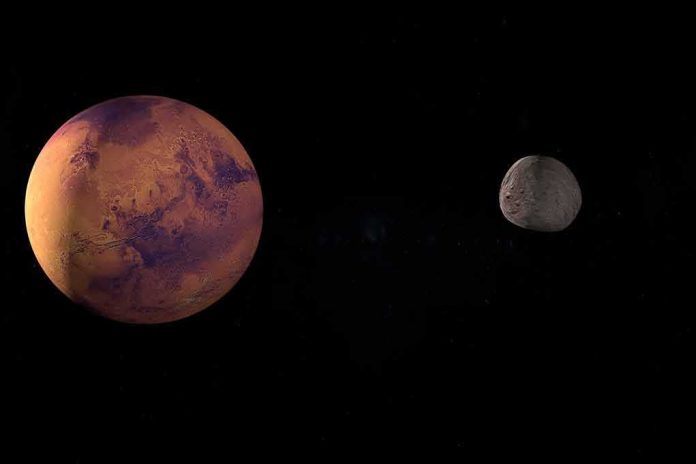
New scientific evidence reveals that ancient Mars may have been warm enough to support life, thanks to volcanic sulfur gas emissions that created a powerful greenhouse effect billions of years ago.
Story Highlights
- Volcanic sulfur gases (H₂S and S₂) likely created greenhouse warming on early Mars 3-4 billion years ago
- New climate models show these emissions could have maintained liquid water on the Martian surface
- Evidence from Martian meteorites and surface minerals supports sulfur-rich volcanic activity
- Findings challenge previous assumptions about Mars being too cold for ancient habitability
Revolutionary Climate Discovery Changes Mars History
Recent peer-reviewed studies published in Science Advances have fundamentally altered our understanding of early Martian climate. Scientists discovered that massive volcanic eruptions between 3 and 4 billion years ago released unprecedented quantities of reduced sulfur gases—primarily hydrogen sulfide and disulfur—into Mars’ atmosphere. These emissions created a greenhouse effect powerful enough to trap heat and maintain surface temperatures above water’s freezing point, potentially making the Red Planet hospitable to life during its ancient past.
Sulfur Gases Provided the Missing Climate Puzzle Piece
For decades, planetary scientists struggled to explain how Mars could have supported the liquid water evidenced by ancient river valleys and lakebeds, given its distance from the Sun and thin atmosphere. Previous climate models focused on carbon dioxide and sulfur dioxide as greenhouse gases but failed to account for geological evidence of widespread sulfate and carbonate deposits. The breakthrough came when researchers analyzed Martian meteorites containing abundant sulfide minerals, revealing that Mars’ early volcanic activity favored the emission of reduced sulfur species rather than oxidized forms.
The planet’s unique redox state during this period allowed volcanoes to release hydrogen sulfide and disulfur gases, which formed heat-trapping atmospheric hazes. These findings reconcile the coexistence of sulfates and carbonates on Mars’ surface, something earlier models couldn’t explain. Climate simulations incorporating these sulfur emissions demonstrate they could have maintained surface temperatures suitable for liquid water flow and accumulation.
Evidence From Multiple Sources Confirms Ancient Habitability Potential
The sulfur greenhouse hypothesis gains credibility from converging lines of evidence across multiple research disciplines. Analysis of Martian meteorites reveals extensive sulfide mineralization consistent with sulfur-rich volcanic outgassing. Surface observations from Mars rovers and orbiters have identified widespread sulfate deposits, indicating past water-rock interactions in a sulfur-rich environment. Geochemical modeling shows that the atmospheric chemistry required for these surface features aligns perfectly with the proposed sulfur gas emissions.
This multi-faceted approach strengthens the case for early Martian habitability by providing a plausible mechanism for maintaining warm, wet conditions. The research suggests that volcanic sulfur cycling was critical in creating environments where liquid water could persist long enough for potential biological processes to develop and thrive.
Future Mars Exploration Targets Sulfur-Rich Regions
These groundbreaking discoveries are reshaping Mars exploration priorities and mission planning. Scientists now advocate for targeting regions with high concentrations of sulfate and carbonate minerals for future sample collection and analysis. The findings increase the scientific justification for Mars sample return missions, as these materials could preserve evidence of ancient atmospheric conditions and potentially biosignatures from when the planet was more hospitable to life.
Sources:
PMC – Sulfur emissions and early Mars climate study
The Debrief – Volcanic eruptions and ancient Mars life potential
Universe Magazine – Early Mars climate and sulfur gases
Science Advances – Reduced sulfur species greenhouse effects
Innovations Report – Sulfur gas warming hypothesis
Ukiyo Journal – Mars volcanic activity and sulfur role



